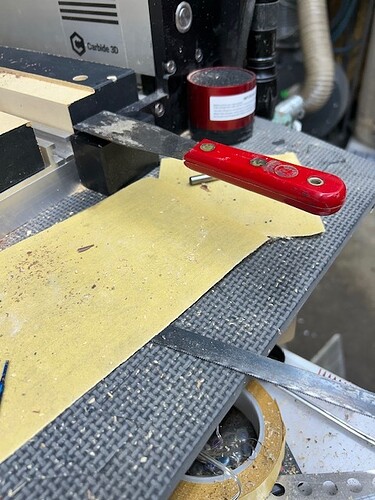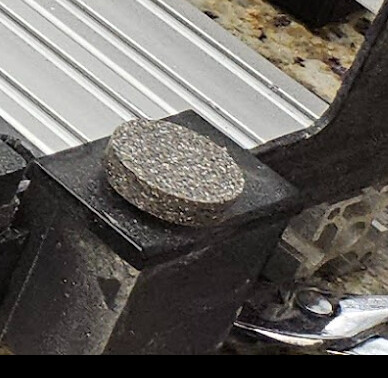I thought I had tooling of my machine figured out and hadn’t had a problem putting tools in the machine, touching off, and then running, so I thought. Well, this morning I started the machine up, initialized it and when it came to the front to touch off on the bit setter at the front right of the machine, I put in the surfacing bit I have. Then the machine touched off the setter and then went to standby mode. I checked my program in CCP and made sure that I had a few added adjustments to accommodate for the smaller part being surfaced. I had the material locked down and moved the tool over to find X and Y zero. Once that was completed I went ahead and touched off the top of the material to set my Z zero.
The program was then loaded into CM and checked for material height to make sure I was running the right material height. Then I started the program and the gantry came back to tool change location and asked for the tool in the spindle. I pressed ok to let the machine go to the bit setter and touch off. Then the machine started the program. It moved over to the start of my surfacing front left side, came down and crashed hard into the holder ripping much of the holders material off, twisting the holder and locking the spindle in spin. I hit the red button.
I turned the machine back on, and re-initialized the machine. I checked the tool and was lucky it was fine. I checked the holder and it was destroyed. The part, luckily, didn’t move. When the machine did another tool check during initialization, it had the same tool in it. When I checked the height of where the machine thought was Z zero, it showed that it thought Z zero was almost .500" deeper then the material. So, I moved the tool back to the height of the material and touched off again. I noted the height from the Z zero on the machine and the location I was originally trying for in the first place. I set Z zero again and loaded the program and started it again. This time I moved the tool of the surfacing off further from the part so it wouldn’t crash down into the holder.
This time the tool came down and was still further down to -.148" rather then the -.020" that I was wanting to cut. I stopped the program. Reset Z zero to the material again, which was off again, and then started the program again. This time it went over and only cut down -.020" like it was supposed to.
So, what the hell was I doing wrong to make this tool come crashing down into my holder like a bad stepchild? Where am I going wrong on setting my Z zero? If the machine has an understanding where the top of the table is and the bit setter is set to understand where the tool end is in comparison to the spindle collet, then why does it have to mess up so much on dealing with Z zero? I run a hundred thousand dollar CNC and when I touch off the tool to the part, the machine knows exactly where the Z zero is. Then when I run the program, I don’t have to worry about the machine Z zero and the tool coming crashing into the part.
So, if I touch off the material on my S5Pro, then it should know where my Z zero is to the machine because the machine already knows where Z home is and where Z zero is to that home. So, if I have the program setup saying the material is .625 thick, the Z zero was touched off to the part, and Z home knows the distance between the two, then why does the machine confuse itself when it touches off the tool to the bit setter? It really is as if the bit setter is really the trouble here. I don’t never use a bit setter on any of my big CNC machines to know where the Z home and Z zero are in comparison.
My question also is how do I actually set my tool in Z zero and make it stay there? When do I set material zero? Or is it unnecessary when using the bit setter? Or is that part of the machine that is attached to the front right of the machine not the bit setter and actually something else? If I load a program, does material Z zero have to be retouched off? If the machine is initialized at startup, does resetting Z zero have to be done after the program is loaded or before? I am a bit lost as to why my machine crashed itself into the material holder and how that setting Z zero two different ways it still almost crashed once and did crash one other time.

